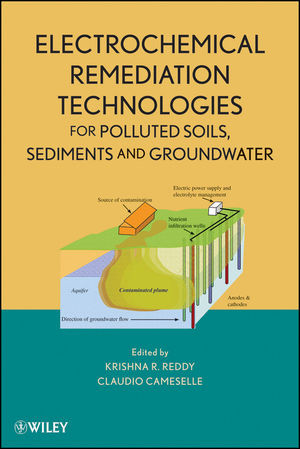

Most ebook files are in PDF format, so you can easily read them using various software such as Foxit Reader or directly on the Google Chrome browser.
Some ebook files are released by publishers in other formats such as .awz, .mobi, .epub, .fb2, etc. You may need to install specific software to read these formats on mobile/PC, such as Calibre.
Please read the tutorial at this link: https://ebookbell.com/faq
We offer FREE conversion to the popular formats you request; however, this may take some time. Therefore, right after payment, please email us, and we will try to provide the service as quickly as possible.
For some exceptional file formats or broken links (if any), please refrain from opening any disputes. Instead, email us first, and we will try to assist within a maximum of 6 hours.
EbookBell Team

0.0
0 reviewsElectrochemical technologies are emerging as important approaches for effective and efficient pollution remediation, both on their own and in concert with other remediation techniques. Electrochemical Remediation Technologies for Polluted Soils, Sediments and Groundwater provides a systematic and clear explanation of fundamentals, field applications, as well as opportunities and challenges in developing and implementing electrochemical remediation technologies. Written by leading authorities in their various areas, the text summarizes the latest research and offers case studies that illustrate equipment, installation, and methods employed in real-world remediations.
Divided into nine sections, the coverage includes:
Introduction and fundamental principles
Remediation of heavy metals and other inorganic pollutants
Remediation of organic pollutants
Remediation of mixed contaminants
Electrokinetic barriers
Integrated (coupled) technologies
Mathematical modeling
Economic and regulatory considerations
Field applications and performance assessment
Unique as a comprehensive reference on the subject, Electrochemical Remediation Technologies for Polluted Soils, Sediments and Groundwater will serve as a valuable resource to all environmental engineers, scientists, regulators, and policymakers.Content:
Chapter 1 Overview of Electrochemical Remediation Technologies (pages 1–28): Krishna R. Reddy and Claudio Cameselle
Chapter 2 Electrochemical Transport and Transformations (pages 29–64): Sibel Pamukcu
Chapter 3 Geochemical Processes Affecting Electrochemical Remediation (pages 65–94): Albert T. Yeung
Chapter 4 Electrokinetic Removal of Heavy Metals (pages 95–126): Lisbeth M. Ottosen, Henrik K. Hansen and Pernille E. Jensen
Chapter 5 Electrokinetic Removal of Radionuclides (pages 127–139): Vladimir A. Korolev
Chapter 6 Electrokinetic Removal of Nitrate and Fluoride (pages 141–148): Kitae Baek and Jung?Seok Yang
Chapter 7 Electrokinetic Treatment of Contaminated Marine Sediments (pages 149–177): Giorgia De Gioannis, Aldo Muntoni, Alessandra Polettini and Raffaella Pomi
Chapter 8 Electrokinetic Stabilization of Chromium (VI)?Contaminated Soils (pages 179–193): Laurence Hopkinson, Andrew Cundy, David Faulkner, Anne Hansen and Ross Pollock
Chapter 9 Electrokinetic Removal of PAHs (pages 195–217): Ji?Won Yang and You?Jin Lee
Chapter 10 Electrokinetic Removal of Chlorinated Organic Compounds (pages 219–234): Xiaohua Lu and Songhu Yuan
Chapter 11 Electrokinetic Transport of Chlorinated Organic Pesticides (pages 235–248): Ahmet Karagunduz
Chapter 12 Electrokinetic Removal of Herbicides from Soils (pages 249–264): Alexandra B. Ribeiro and Eduardo P. Mateus
Chapter 13 Electrokinetic Removal of Energetic Compounds (pages 265–284): David A. Kessler, Charles P. Marsh and Sean Morefield
Chapter 14 Electrokinetic Remediation of Mixed Metal Contaminants (pages 285–313): Kyoung?Woong Kim, Keun?Young Lee and Soon?Oh Kim
Chapter 15 Electrokinetic Remediation of Mixed Metals and Organic Contaminants (pages 315–331): Maria Elektorowicz
Chapter 16 Electrokinetic Barriers for Preventing Groundwater Pollution (pages 333–356): Rod Lynch
Chapter 17 Electrokinetic Biofences (pages 357–366): Reinout Lageman and Wiebe Pool
Chapter 18 Coupling Electrokinetics to the Bioremediation of Organic Contaminants: Principles and Fundamental Interactions (pages 367–387): Lukas Y. Wick
Chapter 19 Coupled Electrokinetic–Bioremediation: Applied Aspects (pages 389–416): Svenja T. Lohner, Andreas Tiehm, Simon A. Jackman and Penny Carter
Chapter 20 Influence of Coupled Electrokinetic–Phytoremediation on Soil Remediation (pages 417–437): M. C. Lobo Bedmar, A. Perez?Sanz, M. J. Martinez?Inigo and A. Plaza Benito
Chapter 21 Electrokinetic–Chemical Oxidation/Reduction (pages 439–471): Gordon C. C. Yang
Chapter 22 Electrosynthesis of Oxidants and Their Electrokinetic Distribution (pages 473–482): W. Wesner, Andrea Diamant, B. Schrammel and M. Unterberger
Chapter 23 Coupled Electrokinetic–Permeable Reactive Barriers (pages 483–503): Chih?Huang Weng
Chapter 24 Coupled Electrokinetic–Thermal Desorption (pages 505–535): Gregory J. Smith
Chapter 25 Electrokinetic Modeling of Heavy Metals (pages 537–562): Jose Miguel Rodriguez?Maroto and Carlos Vereda?Alonso
Chapter 26 Electrokinetic Barriers: Modeling and Validation (pages 563–579): R. Sri Ranjan
Chapter 27 Cost Estimates for Electrokinetic Remediation (pages 581–587): Christopher J. Athmer
Chapter 28 Regulatory Aspects of Implementing Electrokinetic Remediation (pages 589–606): Randy A. Parker
Chapter 29 Field Applications of Electrokinetic Remediation of Soils Contaminated with Heavy Metals (pages 607–624): Anshy Oonnittan, Mika Sillanpaa, Claudio Cameselle and Krishna R. Reddy
Chapter 30 Field Studies: Organic?Contaminated Soil Remediation with Lasagna Technology (pages 625–646): Christopher J. Athmer and Sa V. Ho
Chapter 31 Coupled Electrokinetic PRB for Remediation of Metals in Groundwater (pages 647–659): Ha Ik Chung and MyungHo Lee
Chapter 32 Field Studies on Sediment Remediation (pages 661–696): J. Kenneth Wittle, Sibel Pamukcu, Dave Bowman, Lawrence M. Zanko and Falk Doering
Chapter 33 Experiences With Field Applications of Electrokinetic Remediation (pages 697–717): Reinout Lageman and Wiebe Pool